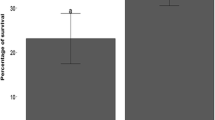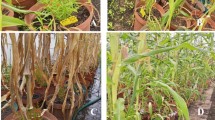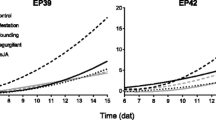Abstract
The feeding preference of European corn borer larvae for immature whorl tissue of maize was examined by conducting leaf bioassays and quantifying resistance factors along the length of mid-whorl leaves from the maize synthetic BS9(C4) developed by recurrent selection for resistance. Potential resistance factors that were quantified included percent foliar nitrogen, gravimetric determination of soluble metabolites and fiber, soluble phenolics and hydroxamic acids, cell-wall-bound phenolics, leaf toughness, and UV absorbance of the epidermal cell wall determined by microspectrophotometry. Larvae consumed immature tissue at a higher rate than more mature tissue outside of the whorl, despite higher levels of DIMBOA in immature tissue. Consumption rate was highly negatively correlated with epidermal cell wall absorbance and leaf toughness. Fiber content and phenolic fortification of cell walls are proposed as the major resistance components that influence European corn borer feeding preference within the resistant synthetic BS9(C4).
Similar content being viewed by others
References
Akin, D.E., Hartley, R.D., Rigsby, L.L., andMorrison, W.H., III. 1992. Phenolic acids released from bermudagrass (Cynodon dactylon) by sequential sodium hydroxide treatment in relation to biodegradation of cell types.J. Sci. Food Agric. 58:207–214.
Ampofo, J.K.O., andKidiavai, E.L. 1987.Chilo partellus (Swinhoe) (Lepid., Pyralidae) larval movement and growth on maize plants in relation to plant age and resistance or susceptibility.J. Appl. Entomol. 103:483–488.
Ascher, K.R.S., Schmutterer, H., Glotter, E., andKirson, I. 1981. Withanolides and related ergostane-type steroids as antifeedants for larvae ofEpilachna varivestis (Coleoptera: Chrysomelidae).Phytoparasitica 9:197–205.
Atkinson, J., Morand, P., Arnason, J.T., Niemeyer, H.M., andBravo, H.R. 1991. Analogues of the cyclic hydroxamic acid 2,4-dihydroxy-7-methoxy-2H-1,4-benzoxazin-3-one: Decomposition to benzoxazolinones and reaction withβ-mercaptoethanol.J. Org. Chem. 56:1788–1800.
Beck, D.L., Dunn, G.M., Routley, D.G., andBowman, J.S. 1983. Biochemical basis of resistance in corn to the corn leaf aphid.Crop Sci. 23:995–998.
Bergvinson, D.J. 1993. Role of phenolic acids in maize resistance to the European corn borer,Ostrinia nubilalis (Hübner). PhD dissertation. University of Ottawa, Ottawa, Ontario, Canada.
Bergvinson, D.J., Arnason, J.T., Hamilton, R.I., Mihm, J.A., andJewell, D.C. 1994a. Determining leaf toughness and its role in maize resistance to the European corn borer (Lepidoptera: Phyralidae).J. Econ. Entomol. In press.
Bergvinson, D.J., Arnason, J.T., andPietrzak, L. N. 1994b. Localization and quantification of cell wall phenolics in European corn borer resistant and susceptible maize inbreds.Can. J. Bot. In press.
Bernays, E.A. 1986. Diet-induced head allometry among foliage-chewing insects and its importance for graminivores.Science 231:495–497.
Bernays, E.A., andBarbehenn, R. 1987. Nutritional ecology of grass foliage-chewing insects, pp. 147–175,in F. Slansky, Jr., and J.G. Godriguez (eds.). Nutritional Ecology of Insects, Mites, Spiders, and Related Invertebrates. John Wiley & Sons, New York.
Buendgen, M.R., Coors, J.G., Grombacher, A.W., andRussell, W.A. 1990. European corn borer resistance and cell wall composition of three maize populations.Crop Sci. 30:505–510.
Campos, F., Atkinson, J., Arnason, J.T., Philogène, B.J.R., Morand, P., Werstiuk, N.H., andTimmins, G. 1989. Toxicokinetics of 2,4-dihydroxy-7-methoxy-1,4-benzoxazin-3-one (DIBOA) in the European corn borer.Ostrinia nubilalis (Hübner).J. Chem. Ecol. 15:1989–2001.
Coors, J.R. 1987. Resistance to the European corn borer,Ostrinia nubilalis (Hübner), in maize,Zea mays L., as affected by soil silica, plant silica, structural carbohydrates, and lignin, pp. 445–456,in W.H. Gabelman and B.C. Loughman (eds.). Genetic Aspects of Plant Mineral Nutrition. Nijhoff, The Hague, The Netherlands.
Feeny, P. 1976. Plant apparency and chemical defense.Recent Adv. Phytochem. 10:1–40.
Ford, C.W., andHartley, R.D. 1989. GC/MS characterization of cyclobutane dimers fromp-coumaric and ferulic acids by photodimerization—a possible factor influencing cell wall biodegradability.J. Sci. Food Agric. 46:301–310.
Hartley, R.D., andJones, E.C. 1976. Diferulic acid as a component of cell walls ofLolium multiflorum.Phytochemistry 15:1157–1160.
Hartley, R.D., Whatley, F.P., andHarris, P.J. 1988. 4,4′-Dihydroxytruxillic acid as a component of cell walls ofLolium multiflorum.Phytochemistry 27:349–351.
Houseman, J.G., Campos, F., Thie, N.M.R., Philogène, B.J.R., Atkinson, J., Morand, P., andArnason, J.T. 1992. Effect of the maize-derived compounds DIMBOA and MBOA on growth and digestive processes of European corn borer (Lepidoptera: Pyralidae).J. Econ. Entomol. 85:669–674.
Iiyama, D., Lam, T.B.T., andStone, B.A. 1990. Phenolic acid bridges between polysaccharides and lignin in wheat internodes.Phytochemistry 29:733–737.
Jung, H.G., andCasler, M.D. 1990. Lignin concentration and composition of divergent smooth bromegrass genotypes.Crop Sci. 30:980–985.
Kato, Y., andNevins, D.J. 1985. Isoltion and identification ofO-(5-O-feruloyl-α-l-arabinofuranosyl-(1→3)-O-β-d-xylopyranoxyl-(1→4)-d-xylopyranose as a component ofZea shoot cell-walls.Carbohydr. Res. 137:139–150.
Klun, J.A., andRobinson, J.F. 1969. Concentration of two 1,4-benzoxazinones in dent corn at various stages of development of the plant and its relation to resistance to the host plant of the European corn borer.J. Econ. Entomol. 59:711–718.
Lee, D.A. 1988. Factors affecting mortality of the European corn borer,Ostrinia nubilalis (Hübner), in Alberta.Can. Entomol. 120:841–853.
Niemeyer, H.M., Pesel, E., Copaja, S.V., Brava, H.R., Franke, S., andFrancke, W. 1989. Changes in hydroxamic acid levels in wheat plants induced by aphid feeding.Phytochemistry 28:2307–2310.
Peterson, S.S., Scriber, J.M., andCoors, J.G.ss 1988. Silica, cellulose and their interactive effects on the feeding performance of the Southern armyworm,Spodoptera eridania (Cramer) (Lepidoptera: Noctuidae).J. Kans. Entomol. Soc. 61:169–177.
Robinson, J.F., Klun, J.A., andBrindley, T.A. 1978. European corn borer: A non preference mechanism of leaf feeding resistance and its relationship to 1,4-benzoxazin-3-one concentration in dent corn tissue.J. Econ. Entomol. 71:461–465.
Rojanaridpiched, C., Gracen, V.E., Everett, H.L., Coors, J.G., Pugh, B.F., andBouthyette, P. 1984. Multiple factor resistance in maize to the European corn borer.Maydica 29:305–315.
Ross, S.E., andOstlie, K.R. 1990. Dispersal and survival of early instars of European corn borer (Lepidoptera: Pyralidae) in field corn.J. Econ. Entomol. 83:831–836.
Russell, W.A., andGuthrie, W.D. 1982. Registration of BS9(CB)C4 maize germplasm (Reg. No. 97).Crop. Sci. 22:694.
SAS Institute. 1988. SAS/STAT User's Guide. Version 6.03. SAS Institute Inc., Cary, North Carolina, 1028 pp.
Scriber, J.M., andSlansky, F., Jr. 1981. The nutritional ecology of immature arthropods.Annu. Rev. Entomol. 26:183–211.
Author information
Authors and Affiliations
Additional information
PRC contribution no. 1562.
Rights and permissions
About this article
Cite this article
Bergvinson, D.J., Hamilton, R.I. & Arnason, J.T. Leaf profile of maize resistance factors to European corn borer,Ostrinia nubilalis . J Chem Ecol 21, 343–354 (1995). https://doi.org/10.1007/BF02036722
Received:
Accepted:
Issue Date:
DOI: https://doi.org/10.1007/BF02036722




